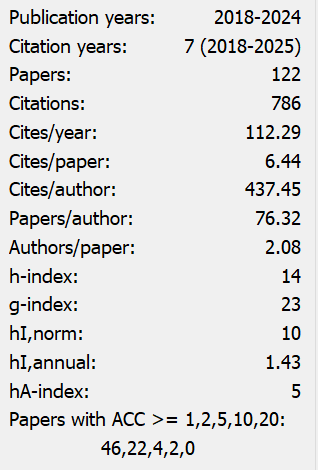The Impact of Digital Transformation on Cost Stickiness in Enterprises
Abstract
Against the backdrop of rapidly advancing emerging digital technologies, digital transformation is increasingly integrated with enterprise production and management activities. Based on data from A-share listed companies in China from 2012 to 2023, this paper investigates the impact of digital transformation on cost stickiness. The study finds that digital transformation significantly suppresses cost stickiness in enterprises, and this conclusion remains robust after a series of sensitivity tests. The inhibitory effect of digital transformation on cost stickiness is more pronounced in small and medium-sized enterprises, asset-intensive firms, non-state-owned enterprises, and enterprises located in central and western regions. Mechanism analysis reveals that digital transformation can reduce cost stickiness by enhancing the quality of internal control and improving the transparency of accounting information. These findings have important implications for encouraging enterprises to accelerate digital transformation, reduce cost stickiness, and achieve high-quality development.
References
[2] Zhang, L., Li, J., & Zhang, H. (2019). Does managerial ability affect cost stickiness? Accounting Research, (3), 71–77.
[3] Zhao, C., Cao, W., Yao, Z., et al. (2020). Does "Internet Plus" help reduce the cost stickiness of enterprises? Journal of Finance and Economics, 46(4), 33–47.
[4] Qi, Y., & Cai, C. (2020). Research on the multiple impacts of digitalization on the performance of manufacturing enterprises and its mechanism. Learning and Exploration, 300(07), 108–119.
[5] Meng, X., & Dong, W. (2022). Enterprise digital transformation and enhancement of export competitiveness: Evidence from Chinese listed companies. International Trade Issues, (10), 73–89.
[6] Ye, C., Xi, L., & Zhang, L. (2016). Corporate governance structure, internal control quality and enterprise financial performance. Audit Research, (2), 104–112.
[7] Yang, S., Xiao, H., & Ji, J. (2023). Internal control, real earnings management and cost stickiness. Friends of Accounting, (24), 92–99.
[8] Wang, C., & Wang, J. (2025). Digital transformation, internal control and enterprise financial risk. Finance and Accounting Communication, (05), 37–41.
[9] Yao, Y. (2022). The impact of enterprise digital transformation on the hollowing out behavior of major shareholders. Contemporary Finance and Economics, (11), 137–148.
[10] Xi, C., & Liu, H. (2024). Digital transformation and the quality of enterprise accounting information. Friends of Accounting, (06), 82–89.
[11] Zhu, H., & Wang, C. (2021). Digital transformation of industries under the strategic background of the "dual circulation" new development pattern: Theory and countermeasures. Finance and Trade Economics, 42(03), 14–27.
[12] Qi, H., Cao, X., & Liu, Y. (2020). The impact of the digital economy on corporate governance: From the perspectives of information asymmetry and irrational behaviors of managers. Reform, (4), 50–64.
[13] Zhang, Y., Li, X., & Xing, M. (2021). Enterprise digital transformation and audit pricing. Audit Research, (03), 62–71.
[14] Anderson, M. C., Banker, R. D., & Janakiraman, S. N. (2003). Are selling, general, and administrative costs “sticky”? Journal of Accounting Research, 41(1), 47–63. https://doi.org/10.1111/1475-679X.00095
[15] Liang, S. (2018). Do institutional investors’ shareholdings affect cost stickiness? Management World, 34(12), 133–141.
[16] Wu, F., Hu, H., Lin, H., & Ren, X. (2021). Enterprise digital transformation and capital market performance: Empirical evidence from stock liquidity. Management World, 37(07), 130–144+10.
[17] Liu, Y. (2022). Digital economy empowering high-quality development of enterprises: Empirical evidence based on total factor productivity of enterprises. Reform, (9), 35–53.
[18] Jiang, T. (2022). Mediating and moderating effects in empirical research on causal inference. China Industrial Economics, (5), 100–120.
[19] Li, R., Dang, S., Li, B., & Yuan, R. (2022). The information technology background of CEOs and the quality of enterprise internal control. Audit Research, (01), 118–128.
[20] Xin, Q., Kong, D., & Hao, Y. (2013). Corporate transparency and stock price volatility. In Proceedings of the 2013 Academic Annual Conference of the Chinese Accounting Society (pp. 29). Chinese Accounting Society.
[21] Wang, Y., Guo, X., & Yu, Y. (2020). Anti-monopoly and competitive neutrality in the debt market. Accounting Research, (07), 144–166.
[22] Luo, Y., & Zhang, M. (2024). Environmental regulation and corporate tax compliance: Effects, mechanisms and improvement paths. Journal of Quantitative & Technical Economics, 41(08), 175–196.
[23] Yin, M., Sheng, L., & Li, W. (2018). Executive motivation, innovation input and corporate performance: An empirical study by industry from the perspective of endogeneity. South Kai Management Review, 21(01), 109–117.

This work is licensed under a Creative Commons Attribution 4.0 International License.
Copyright for this article is retained by the author(s), with first publication rights granted to the journal.
This is an open-access article distributed under the terms and conditions of the Creative Commons Attribution license (http://creativecommons.org/licenses/by/4.0/).


























